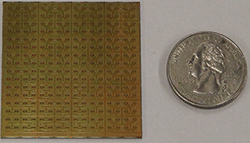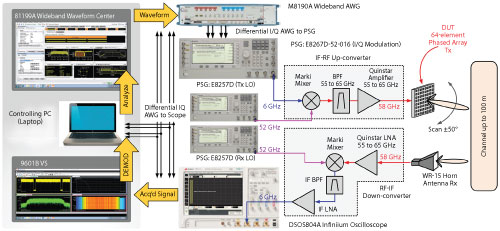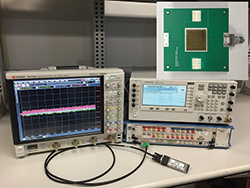
Figure 1 UCSD’s 5G 64- and 256-element, 60 GHz silicon wafer-scale phased array transmitter with beam forming capabilities.
Today’s wireless communications industry is on the verge of a revolution. While much has already been written about the need for higher data rates and therefore, wider bandwidths, the industry is also being driven to find ways to serve more users in a given area—a concept generally referred to as “densification.” This need has prompted interest in utilizing less populated frequency spectrum in the microwave and millimeter wave (mmWave) bands, and it is shifting the industry from one in which power is transmitted over a physically broad area to one where it is transmitted in a very directive manner. In this new era of directive communication, one or more beams of energy can be sent directly to a single user, enabling higher frequency reuse, as well as a higher quality of service and better overall experience. Directive communications is quite a technological leap at consumer price points and if realized, promises to enable a wealth of possibilities for 5G and beyond, including a host of new terrestrial and airborne applications, with data services provided much more effectively and inexpensively to a wider population.
Key to enabling this “5G densification” is the antenna, which for directive communication must be physically large (typically greater than 8×) relative to the wavelength of the transmission. Keeping the antennas to a size manageable for commercial use, however, requires short wavelengths or higher frequencies—a fact that has driven great interest in the unregulated 60 GHz band. The most commonly used standard is IEEE 802.11ad (WiGig) that provides multi-gigabit data rates up to 7 Gbps by utilizing a beam forming protocol that employs phased array transmitters and receivers to improve channel efficiency and system performance, and assist users in aligning the transmission path.
While the promise of 5G and multi-gigabit speed wireless communication is enticing, enabling this reality has required two key breakthroughs: development of low cost phased arrays and proof that they can actually be used in a 5G communications link. The latter part of that challenge is exactly what researchers from the University of California, San Diego (UCSD), in collaboration with Keysight Technologies, set out to address last year. What resulted represents a significant step forward in achieving those breakthroughs—successful demonstration of the world’s first 64 (8×8) and 256-element (16×16), 60 GHz silicon wafer-scale phased array transmitter with integrated high efficiency antennas for Gbps communications over several hundred meters. The demonstration not only proved the viability of such a link, but that it could deliver record performance as well.
A Strong Foundation
Getting to that demonstration took a great deal of effort and hinged on two critical factors. One was the development of the industry’s first 64- and 256-element system-on-a-chip (SoC) phased arrays operating at 60 GHz (see Figure 1). That development sprung from an earlier effort between UCSD and TowerJazz that was sponsored by the Defense Advanced Research Projects Agency (DARPA). The resulting wafer-scale SoCs each comprised a 60 GHz source, amplifiers, distribution network, phase shifters, voltage controlled amplifiers and high efficiency on-chip antennas. This SoC is targeted for 5G advanced communications systems and aerospace/defense applications.

Figure 2 Measurement setup used for the 60 GHz communication link.

Figure 3 Measurement setup for the 60 GHz 802.11ad and 5G link measurements with the UCSD 64-element wafer-scale phased array.
The other factor was a long history of collaboration between UCSD and Keysight; one that began some 10 years earlier when Keysight began funding a MEMS (microelectromechanical systems) development effort at UCSD. In 2015, Keysight solidified its relationship with UCSD by officially signing on as an industry affiliate for its Center for Wireless Communication.
It was about this time that UCSD had just finished developing its phased array SoCs and were ready to take the next step—proving that the chips could be used in a 5G communication link. To do that, UCSD needed a hardware and software measurement system; one that had the necessary performance and accuracy, and could be operated by the small number of UCSD researchers working on the project.
Measurement Setup
The measurement system also had to be fast. UCSD’s researchers invested a great deal of time and effort developing the antenna, roughly two and a half years. In just a matter of days, the necessary measurement setup for the 60 GHz communication link was in place, a 60 GHz link at 4m, 30m and approximately 100m link was developed, and the performance of the 64-element transmit phased array was successfully demonstrated.
To develop that link, an instrument setup was developed as shown in Figure 2. The instruments included a M8190A arbitrary waveform generator, E8267D PSG vector signal generator and DSOS804A Infiniium S-Series high definition oscilloscope with 10-bit ADC. For local oscillator generation, the E8257D PSG analog signal generator was used. Standard software was used to generate a 60 GHz 802.11ad waveform, apply digital predistortion and improve the error-vector-magnitude performance. The actual setup is shown in Figure 3.
Once the communication link was developed, the next step was to measure it at link distances of 4m, 30m and 100m. To do that, UCSD’s 64-element phased array transmitter was placed on a tripod so that the scanning performance of the array could be measured with a communication waveform. A stationary horn antenna with a gain of 20 dB acted as the receiver, and for measurement purposes was coupled to oscilloscope running demodulation software.
Constellations were then measured for different modulation schemes, center frequencies and scanning angles. For the longer distances, the transmitter was placed on the roof of a six-story building, while the receiver was situated in a parking lot, introducing additional challenges with interference from cars and trees.
In both cases, measured constellations showed that the 60 GHz communication link worked well. At the 4 m link distance (full 802.11ad channel), the 64-element phased array transmitter was able to maintain a complex communication link at all scan angles (±45º in all planes) and with virtually no added distortion, achieving a 16-QAM modulation with 3.85 Gbps. Nearly the same performance was achieved at 30 m. Over the 100 m link distance, the communication link was able to achieve a QPSK modulation with 1.54 Gbps while scanning to ±45° in all planes.
Looking to the Future
The successful demonstration of the world’s first 5G communication link based on a 64- and 256-element phased-array transmitter with beam-pointing capabilities, represents a significant step forward in the realization of 5G. But it is not the end of the story as phase three of the research project is already underway with UCSD researchers now focused on developing transmit/receive components, larger arrays and more efficient networked 5G systems over the next year.
Like the 5G communication link, any new developments to stem from the ongoing research hold great promise for helping the industry evolve to an era of 5G directive communication. Just as critically, it will help pave the way for future research and development of mmWave communication systems.
References
- S. Zihir, O.D. Gurbuz, A. Karroy, S. Raman and G.M. Rebeiz, “A 60 GHz 64-element Wafer-Scale Phased-Array with Full-Reticle Design,” International Microwave Symposium, Phoenix, Ariz., May 2015.
- Samet Zihir, Ozan D. Gurbuz, Arjun Karroy, Sanjay Raman and Gabriel M. Rebeiz, “A 60 GHz Single-Chip 256-Element Wafer-Scale Phased Array with EIRP of 45 dBm Using Sub-Reticle Stitching,” IEEE RFIC Symposium, Phoenix, Ariz., May 2015.
Mark Pierpoint is the vice president and general manager of Internet Infrastructure Solutions at Keysight Technologies. Pierpoint leads the company’s focus on network equipment, transport links and cloud, including Keysight’s 5G Program. Pierpoint holds a Ph.D. in microwave engineering and a B.Sc. in electrical & electronic engineering from the University of Leeds in the UK. He serves on a number of advisory boards for electrical and computer engineering, including UCSD and the Broadband Wireless Access Center, part of NSF’s I/UCRC program.
Gabriel M. Rebeiz (IEEE Fellow) is distinguished professor and wireless communications industry endowed chair at ucsd. He was elected a member of the National Academy of Engineering in 2016, and his group has won the IEEE MTT Microwave Prize twice for work on phased arrays and RF MEMS. He is considered one of the fathers of RF MEMS and tunable networks, and low cost phased arrays based on silicon RFICs. Rebeiz is an advisor to several of the large commercial and defense electronics and communication system companies in the United States.
